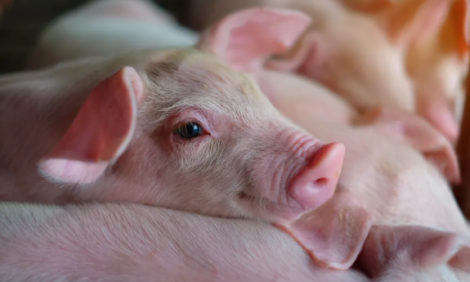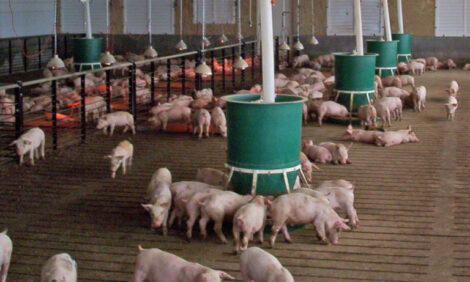



Nebraska Swine Report 2005 : Effects of Nutrition During Gilt Development on Sow Lifetime Productivity
By Rodger K. Johnson and Phillip S. Miller and published by the University of Nebraska - A four-parity study is proposed to examine the effects of nutritional manipulation during gilt development on subsequent sow performance.
Summary and Implications
Gilts will be selected from two
genetic lines that are highly prolific,
but differ in rate and composition of
growth. During the development
period (45 to 250 lb), gilts will be
provided either; i) ad libitum access
to feed, or ii) ad libitum access to feed
until 120 days of age (180 lb) and
75% of ad libitum feed intake thereafter
(until first post-pubertal estrus).
Sow and litter performance criteria
will be examined. In addition, the
economics of sow productivity and
longevity will be evaluated using a
return on equity model. Crossbred
females of the Nebraska Index Line
(NIL) with other maternal lines are
being used in several herds within
Nebraska and the United States. Not
only has there been little research
conducted investigating the effects
of nutritional manipulation during
gilt development on future sow productivity
of the NIL crosses, but little
information is available regarding
how gilt development (as affected by
nutritional manipulation) influences
sow productivity of early-maturing,
prolific sows. Results from this
research project will help producers
make decisions regarding the management
of replacement gilts and
define management scenarios that will
optimize sow lifetime productivity.
Project progress and research data
updates will be provided annually in
the University of Nebraska Swine
Report until the completion of the
study.
Introduction
Ten to 20 years ago, annual
sow death losses of 4 to 5% and
annual sow replacement rates of
35 to 45% were typical in commercial
swine herds. Today, much
of the industry is experiencing
average annual sow death losses
of 10 to 12%, and death losses as
high as 18% in some herds have
been reported. As a result of
increased sow death losses and
other causes of involuntary culling,
annual sow replacement rates
of 45 to 55% are commonplace,
and rates of 60% have occurred in
some herds.
Causes of increased sow losses
are not well documented, but sow
housing systems and management
practices have not changed greatly
during this period. Gilts are
developed to grow as rapidly as
possible, mated at their second or
third post-pubertal estrus, and
mated again for the next litter
within five to 10 days of weaning
a litter (after a 15- to 21-day lactation
period). It is commonly
believed that the increased
annual sow replacement rates are
related to one or more of the following:
genetic selection for prolificacy
or selection for increased
leanness and faster growth rate
that has occurred in developing
modern maternal lines.
In addition, it is generally
accepted that gilts will be provided
ad libitum access to feed
until 230-250 lb; thereafter, gilts
are limit fed until flushing/
breeding at approximately 300 lb.
This system of gilt management
may not be appropriate for all
maternal lines. Specifically, gilts
of prolific, early-maturing lines
may be able to enter the sow herd
at body weights < 300 lb without
compromising lifetime productivity
and(or) health status. Therefore,
protocols should consider
controlling (limiting) feed intake
prior to 230-250 lb.
In this project, we propose to
determine whether alternative gilt
nutritional development strategies
affect longevity and lifetime productivity
of prolific lines of pigs.
Gilts of two lines will be fed two
different dietary regimens during
the gilt development
period in a 2 × 2 factorial arrangement
of treatments and evaluated
for reproduction traits through
four parities. Two highly prolific
genetic lines that differ in rate
and composition of growth will
be used. The two genetic groups
will be produced by mating
commercial Large White-
Landrace cross females, used
regularly in the University of
Nebraska (UNL) nutrition
research program, with semen of
boars of another commercial
maternal line or with Nebraska
Index Line (NIL) boars.
Development of the Nebraska
Index Line. The University of
Nebraska has a long history of
research in genetics and physiology
of reproduction. Early work
determined that ovulation rate is
35-40% heritable and responds to
selection, but because of limitations
in embryonic survival and
uterine capacity, only about 25%
of the increase in ovulation rate is
realized in increased litter size.
The limitation was overcome by
selecting for an index of ovulation
rate, embryonic survival, uterine
capacity and litter size. During
21 generations of selection, the
NIL that averages 13.5 to 14 pigs
per litter, 45% greater than the
control, was developed. Crossbred
gilts of NIL with Monsanto Choice
Genetics Line 34 (GPK34) were
entered into the NPPC Maternal
Line Evaluation Project (MLE)
along with gilts of five other commercial
organizations. The NIL ×
GPK34 (a gilt expected to be similar
to the one to be developed for
this study) had 30 to 50% greater
production through four parities
than the other females. As a result,
the NIL was released to the
industry and is being used in several
breeding programs. It currently
is recognized as one of the
most prolific females available to
swine breeders. Therefore, the
objective of this proposal is to
determine whether alternative gilt
development strategies affect longevity
and lifetime production of
two prolific maternal lines.

Procedures
Description of gilts to be evaluated:
Gilt Population I (P1): A cross of
boars of commercial maternal
line (LM) with UNL Large
White-Landrace gilts
Gilt Population II (P2): A cross of
LM with NIL gilts
The UNL Large White and
Landrace lines and the commercial
line LM are industry lines selected
for increased prolificacy,
growth rate, and leanness. The
NIL is a line produced within the
UNL genetics research program
that has been selected 21 generations
for increased prolificacy with
very little selection for increased
growth and improved leanness.
P1 and P2 gilts are expected to
have reproductive, growth, and
lean similar to that of certain
crosses that were evaluated in the
NPPC MLE (Table 1).
Pigs will be housed and procedures
will be conducted, at the
UNL Swine Unit, Ithaca, Neb. All
procedures and treatments will
be in accordance with UNL Institutional
Animal Care and Use
Committee guidelines. Breedings
to produce the aforementioned
lines will initiate in early September,
2004. Accordingly, females
(50 litters available per treatment;
25 litters/line) will be born in January,
2005 (Replicate 1). The breeding
regimen used to develop
Replicate 1 will be repeated beginning
January, 2005 to create
Replicate 2. Therefore, 200 gilts
(50 gilts per population × dietary
treatment) will be used. Females
will be selected for the experiment
at or prior to weaning (17 to
21 days postfarrowing). Two
females per litter will be identified
and randomly selected for
future allotment to one of the dietary
regimens (see below). After
weaning, all gilts will be grouphoused
in a modified-open-front
building (approx. 8 to 10 pigs/
pen). Gilts will have ad libitum
access to a standard three-phase
grower diet system (Phase 1, 1.15%
lysine; Phase 2, 1.00% lysine; Phase
3, 0.90% lysine; 45 to 80 lb, 80 to
130 lb, and 130 to 180 lb, respectively).
Diets will be corn-soybean
meal-based with .15% crystalline
lysine included.
At approximately 120 days
(180 lb), half (n = 25/line) of the
gilts will continue to be given ad
libitum access of a 0.70 % lysine
diet (0.70% Ca, 0.60% P; TRT 1)
until breeding. The remaining 25
gilts/line will be limit fed (75% of
ad libitum intake) a diet containing
0.93% lysine (1.0% Ca, .80% P;
TRT 2) until breeding. At 140 days
of age, gilts will be heat checked
twice daily using an intact boar.
Pubertal estrus will be recorded
and matings will begin at the first
post-pubertal estrus. From day 0
to breeding, growth performance
criteria and real-time ultrasound
measurements (back fat (BF) thickness
and longissimus muscle area
(LMA)) will be recorded every two
weeks. Gestation and lactation
management will be identical for
all sows. Sows will receive
approximately 4 lb of a 0.55% lysine
diet during gestation and have ad
libitum access to lactation diets
(1.0% lysine). Body weight, BF and
LMA will be recorded at each farrowing
and weaning. Any cross
fostering to equalize litter size will
be conducted within three days
postfarrowing. The following sow
performance criteria will be collected:
litter size (total and live),
number and weight of pigs at
weaning, and return to estrus (relative
to weaning date). Pigs will be
weaned at 17 to 21 days post weaning.
Daily heat checking will be
initiated three days postweaning
until expression of estrus. Sows
will be bred at the first or second
estrus postweaning. Sows that are
not bred by day 21 postweaning
will be culled. Sows will remain
on treatment for a maximum of
four consecutive parities. Criteria
for gilts to be allocated to treatment
and sow culling procedures
to be used are described in the
Maternal Line National Genetic
Evaluation Program Results
(NPPC; April, 2000). The economics
of sow productivity and longevity
will be evaluated using the
NPPC Return on Equity (ROE)
Model.
Anticipated Results
Based on the MLE, when gilts were developed with the common industry practices, expected differences between P1 and P2 gilts are described in Table 1. We hypothesize that feed restriction (prior to 250 lb) will not adversely affect productivity or health status of the P2 gilt line; however, reduced energy intake during late development will reduce lifetime productivity of the P1 line.
Further Information
To view the full list of Nebraska Swine Report 2005 articles, click here
Source: University of Nebraska, Lincoln - September 2005








